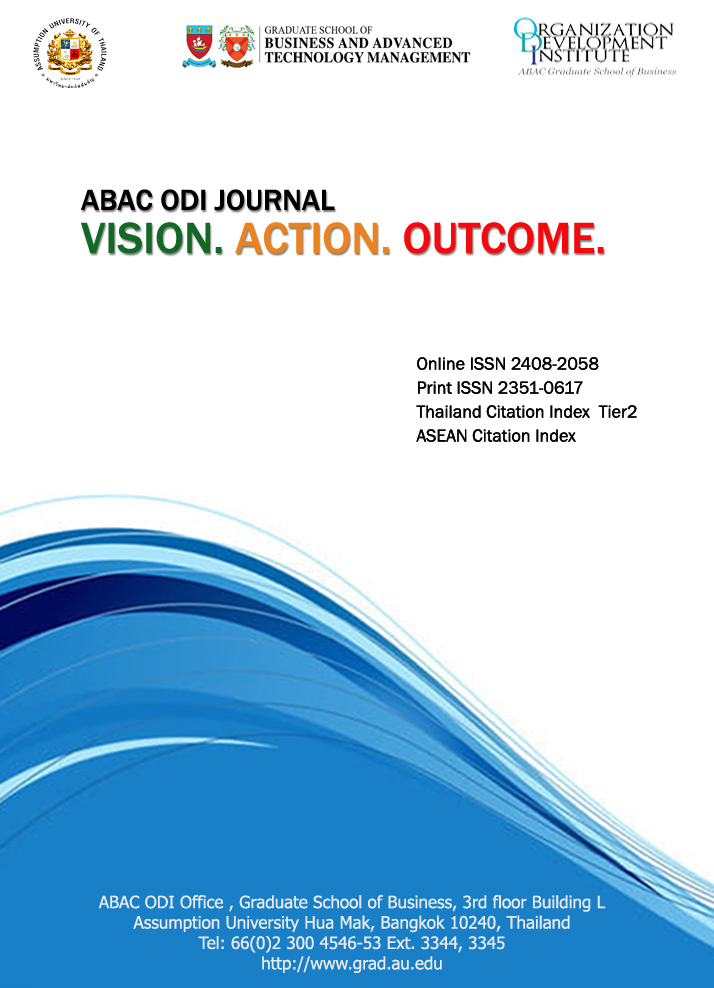How's My English? The English Communication Needs of Wellness Spa Therapists in Thailand
DOI:
https://doi.org/10.14456/abacodijournal.2021.5Abstract
This study focuses on the English communication needs of wellness spa therapists in Thailand. This is supported by an objective: to identify the needs of spa therapists in English communication specifically to the target situation. This study is deemed important so that a specific English language course can be recommended. The study employed a qualitative method employing observation and semi-structured interviews as instruments to collect data and used purposive sampling to select the participants. There were 30 spa therapists and one assistant manager participated in this study. The findings revealed that spa therapists have different needs with regards to English communication in the target situation. This includes 1) the needs for familiarization of the basic English pronunciation; 2) the needs for knowing specific vocabularies while dealing with customers' situation and needs, and 3) the needs for knowing different phrases and sentences to construct different word-formation. The implication based on the findings, therefore, is that, pedagogically, it is recommended that, ideally, a course should be developed for the spa therapists that can focus on the English language communication that could help them with specific vocabularies, words, and phrases to be used in the target situation. Consequently, as wellness centers are normally visited by people from different part of the world, the aim therefore should not be on the English language alone but varieties of English that people used globally, so that spa therapists would know ‘what words to be used’, ‘how words should be used’ and ‘what context should be used.
References
Alfehaid, A. F. T. (2011). Developing an ESP curriculum for students of health sciences through needs analysis and course evaluation in Saudi Arabia [Unpublished Doctoral dissertation]. University of Leicester, Leicester, United Kingdom.
Al-Khresheh, M. H., & Al-Ruwaili, S. F. (2020). An Exploratory Study into Vocabulary Learning Strategies Used by Saudi EFL learners. Journal of History Culture and Art Research, 9(2), 288-302.
Basturkmen, H. (2010). Developing courses in English for specific purposes. Springer.
Brown, J.D. (2016). Introducing needs analysis and English for specific purposes. New York: Routledge.
Bosker, H. R., Pinget, A.F., Quene, H., Sanders, T., & De Jong, N. H. (2013). What makes speech sound ´ fluent? The contributions of pauses, speed and repairs. Language Testing, 30, 159–175.
Bundgaard-Nielsen, R., Best, C.,& Kroos, C., & Tyler, M. (2012). Second language learners’ vocabulary expansion is associated with improved second language vowel intelligibility. Applied Psycholinguistics, 33, 643–664
Crystal, D. (2003). English as a global language. (2nd ed.). Cambridge, United Kingdom: Cambridge University Press.
Dudley-Evans, T. & St John, M.J. (1998). Developments in English for specific purposes: A multi-disciplinary approach. Cambridge, United Kingdom: Cambridge University Press.
Dunne, L. and Seaton, L.T. (2001). Does hormone replacement therapy (HRT) improve cognitive function or either delay or prevent dementia in postmenopausal women?. Journal of Family Practice, 50(6).
Fraenkal, J.R., Wallen, N., & Hyun H.H. (2016). How to design and evaluate research in education (9th ed.). New York: McGraw-Hill Education.
Gavran, S. (2013). The importance of English language learning and teaching in South Korea. Journal of Education and Human Development.
Hattani, H. A. (2019). ESP Needs Analysis at the Moroccan University: Renewable Energy Engineering Students at EST Fes as a Case Study. Journal of English Language Teaching and Linguistics, 4(1), 101-115.
Heigham, J. & Croker, R.A. (2009). Qualitative research applied linguistics a practical introduction. New York: Palgrave Macmillan.
Hutchinson, T. & Waters, A. (1987). English for specific purposes: A learning-centered approach. Cambridge, UK: Cambridge University Press.
Kırkgöz, Y., & Dikilitaş, K. (Eds.). (2018). Key issues in English for specific purposes in higher education (Vol. 11). Springer.
Ministry of Foreign Affairs, Thailand. (2017). New engine of growth. https://www.boi.go.th/upload/content/TIR_Mar17_17989.pdf
Nadar, N.V.M., Vijayakanthi, V., Bertheu, Vasanthi, T.L., & Rathibai, J.P. (2008). English language teaching: First year. Chennai: Tamilnadu Teatbook Corporation.
National Statistical Office, Ministry of Information and Communication Technology. (2017). Summary of the labor force survey in Thailand: January 2017. http://web.nso.go.th/en/survey/data_survey/200260_summary_Jan_2017.pdf
Palinkas, L.A., Green, C.A., Wisdom J.P., & Hoagwood K.E. (2013 November). Purposeful sampling for qualitative data collection and analysis in mixed method implementation research. Journal of Mental Health Services Research, 42(5). DOI: 10.1007/s10488-013-0528-y
Puimège, E., & Peters, E. (2019). Learning L2 vocabulary from audiovisual input: an exploratory study into incidental learning of single words and formulaic sequences. The Language Learning Journal, 47(4), 424-438.
Robson, M. (2013). Foreword. The English effect. London: The British Council.
Saldana, J. (2009). The coding manual for qualitative researchers. London: SAGE Publications Ltd.
Saito, K., Suzukida, Y., & Sun, H. (2019). Aptitude, experience, and second language pronunciation proficiency development in classroom settings: A longitudinal study. Studies in Second Language Acquisition, 41(1), 201-225.
Schmitt, N. (2010). Researching Vocabulary: A Vocabulary Research Manual. New York: Palgrave Macmillan.
Sinhaneti, K. and Apichatrosjanakul P. (2012). An English communicative framework for spa therapists in Bangkok, Thailand. International Journal of Business and Management Studies.
Sok, S., & Han, Z. (2020). A study of L2 vocabulary acquisition under incidental and intentional conditions. Vigo International Journal of Applied Linguistics, (17), 113-140.
Steger, M.B. (2003). Globalization a very short introduction. Oxford, New York: Oxford University Press.
Stone, R. [@rosettastone] (March 19, 2015). Top 10 spoken language in the world. [Tweet]. Twitter. https://twitter.com/rosettastone/status/578542734773866496?lang=en
Swales, J. (1990). Genre analysis: English in academic and research settings. Cambridge University Press.
Swann, M., Peacock, A., Hart, S., and Drummond, M.J. (2012). Creating Learning without Limits. Maidenhead, Open University Press.
Ur, P. (2012). A course in English language teaching. Cambridge: Cambridge University Press.
Vimolsiri, P. (2017). Thailand 20-year strategic plan and reforms. https://www.set.or.th/thailandfocus/files/20170829_Dr_Porametee.pdf
Weedmark, D. (2019, June 01). Importance of English in business communication. https://bizfluent.com/about-6710260-importance-english-business-communication.html
World Travel and Tourism Council. (2012). The comparative economic impact of travel & tourism.https://s3.amazonaws.com/tourism-economics/craft/Case-Studies-Docs/The_Comparative_Economic_Impact_of_Travel__Tourism.pdf
World Travel and Tourism Council. (2017). Travel & tourism global economic impact & issues 2017. http://www.databank.com.lb/docs/The%20Economic%20Impact%20of%20Travel%20and%20Tourism,%20March%202017,%20WTTC.pdf



